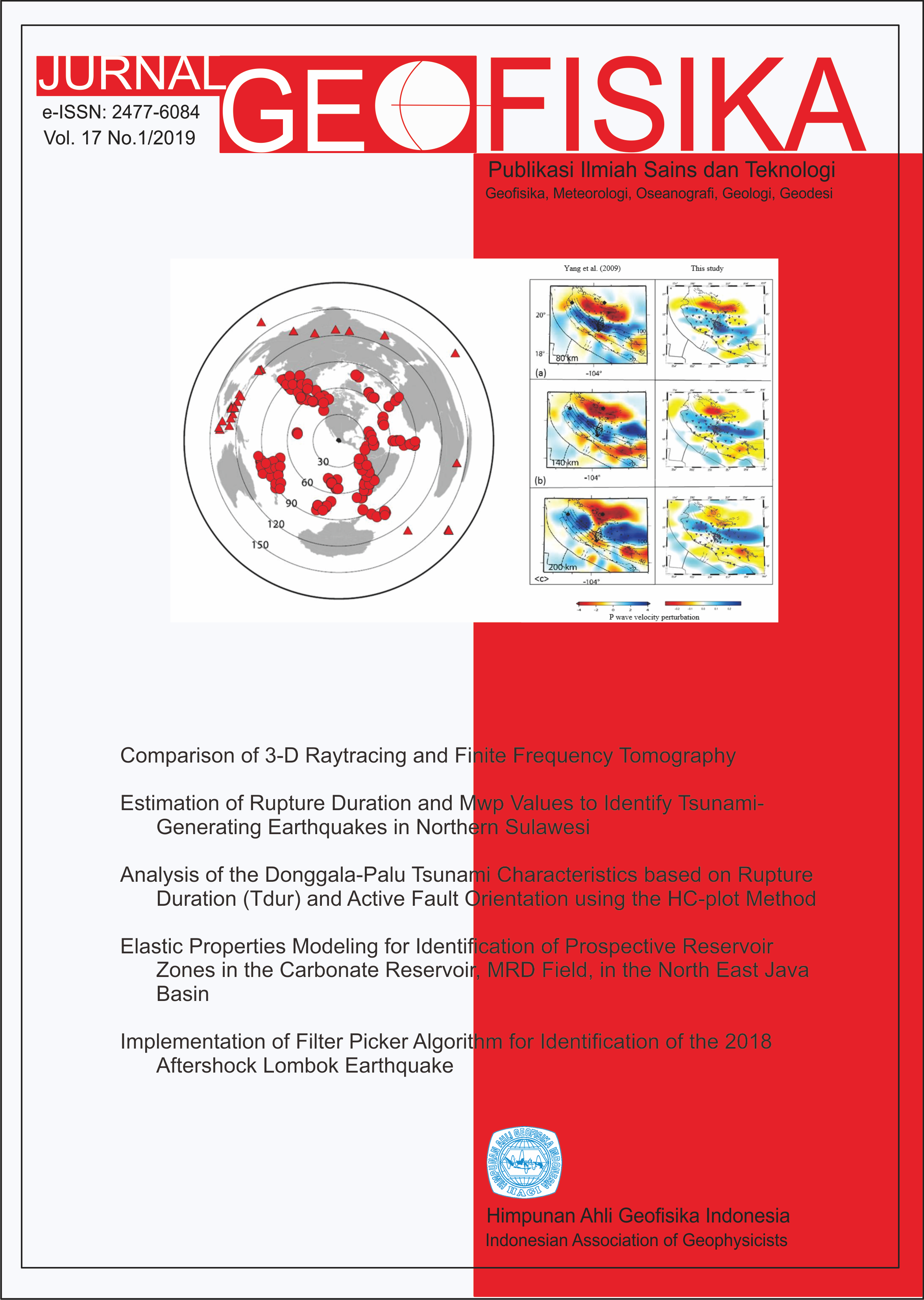Comparison of 3-D Raytracing and Finite Frequency Tomography
Keywords
3-D Raytracing, Finite Frequency, Teleseismic, Southwest Mexico, Subduction ZoneAbstract
We performed 3-D seismic tomography using teleseismic arrival time at Southwest Mexico. The Mexican subduction zone results from successive fragmentation events that affected the ancient Farallon plate as various segments of the East Pacific rise approached the paleo-trench off western North America. The complexity in this region is related to two subducting oceanic plates, the Rivera and Cocos plates, that have different ages, compositions, convergence velocities and subduction dip angles. In this study, we compared the 3-D raytracing tomography model with finite frequency tomography model. Final models show the differences in amplitude and pattern between the raytracing and finite frequency. 3D raytracing models produced sharper images of fast velocity structures in the mantle. The deeper slabs are more coherent and show less broadening with depth than using 1D finite frequency kernels. However, although the finite frequency and 3-D ray tracing models show some differences in amplitude and pattern, the overall agreement of the models supports the interpretation of Yang et al. (2009) that slab rollback is occurring in South Western Mexico. One possible different interpretation between the raytracing and finite frequency theory results concerns the deep structure of the Rivera slab. The finite frequency models show that the Rivera slab is clearly observable at a depth of about 300km but fades away at greater depths. However, the 3-D ray tracing model shows a clear fast velocity band down to a depth of 400 km and thus our model does not support a slab tear of the Rivera plate above 400 km depth
References
Buske, S., and Kastner, U., (2004), Efficient and accurate computation of seismic travel times and amplitudes. Geophysical Prospecting, 52, 313{322.
Constable, S.C., Parker, R.L., and Constable, C.G., (1987), Occam's inversion: a practical algorithm for generating
smooth models from electromagnetic sounding data, Geophysics, 52, 289{300.
Dahlen, F. A., Hung, H. S. and Nolet, G., (2000), Frechet kernels for finite frequency traveltimes, I: Theory, Geophysical Journal International, 141, 157{174.
Ferrari, L., Petrone, C. and Francalanci, L., (2001), Generation of oceanic-island basalt-type volcanism in the western Trans-Mexican volcanic belt by slab rollback, asthenosphere infiltration, and variable ux melting, Geology, 29, 507-510.
Ferrari, L., (2004). Slab detachment control on mafic volcanic pulse and mantle heterogeneity in central Mexico,
Geology, 32(1): 77 { 80.
Gardine, M., Dominguez, T., West, M., Grand, S., Suhardja, S., (2007), The Deep Seismic Structure of Volcan de Colima, Mexico Eos Trans. AGU, 88(23), Fall Meeting Supplementary, Abstract T51A-02.
Hole, J. A., and Zelt, B. C., (1995), 3-D Finite-difference reflection travel times, Geophysical Journal International,
121, 427{434.
Hung, S.H., Dahlen, A. F. and Nolet G., (2001), Wavefront healing: A banana-doughnut perspective, Geophysical
Journal International, 146, 289{312.
Hung, S.H., Shen, Y. and Chiao, Y. L., (2004), Imaging seismic velocity structure beneath the Iceland hot spot: A finite frequency approach, Journal of Geophysical Research, 109, B08305, doi: 10.1029/2003JB002889.
Julian, B. R., and Gubbins, D., (1977), Three-dimensional seismic ray tracing: Journal of Geophysics, 43, 95{113.
Kennett, B. L. N., and Engdahl, E. R., (1991), Traveltimes for global earthquake location and phase identification,
Geophysical Journal International, 122, 429{465.
Kennett, B. L. N., Engdahl, E. R. and Buland, R., (1995), Constraints on seismic velocities in the Earth from travel
times, Geophysical Journal International, 122, 108 { 124.
Kennett, B. L. N., Sambridge, M. S. and Williamson, P. R., (1988), Subspace methods for large scale inverse problems involving multiple parameter classes, Geophys. J., 94, 237 { 247.
Marquering, H., F. A. Dahlen, and G. Nolet., (1999), Threedimensional sensitivity kernels for finite-frequency travel times: The banana-doughnut paradox, Geophysical Journal Internacional, 137, 805{ 815.
Montelli, R., Nolet, G., Masters, G., Dahlen, F. A. and Hung, S.-H., (2004), Global P and PP travel time tomography:
rays versus waves. Geophysical Journal International, 158, 637{654.
Rawlinson, N. and Sambridge, M., (2003), Seismic traveltime tomography of the crust and lithosphere, Advances in Geophysics, 46, 81-198.
Rawlinson, N. and Sambridge M., (2005), The fast marching method: An eective tool for tomographic imaging and tracking multiple phases in complex layered media, Explor. Geophys., 36, 341-350.
Sambridge, M. S., and Kennett, B. L. N., (1990), Boundary value ray tracing in a heterogeneous medium: A simple
and versatile algorithm: Geophysical Journal International, 101, 157{168.
Stock J. M. and Lee, J.,(1994). Do microplates in subduction zones leave a geological record? Tectonics, 13, 6, 1472-1487.
Urn, J. and Thurber, H. C., (1987), A fast algorithm for twopoint seismic ray tracing, Bull. Seismic Society of America, 77, 972-986.
Van Decar, J. C. and Crosson, S. R., (1990), Determination of teleseismic relative phase arrival times using multichannel cross-correlation and least squares, Bull. Seismol. Soc. Am., 80, 150{ 169.
Van Trier, J., and Symes, W. W., (1991), Upwind Finite difference calculation of travel times, Geophysics, 56,
812{821.
Vidale, J. E., (1988), Finite difference calculations of traveltimes: Bulletin of the Seismological Society of America,
78, 2062{2076.
Yang, T., Shen, Y., van der Lee S., Solomon, C. S. and Hung, H. S., (2006), Upper mantle structure beneath the Azores hotspot from finite-frequency seismic tomography, Earth and Planetary Science Letter, 250, 11 {26.
Yang, T., Grand, P. S., Wilson, D., Guzman-Speziale, M., Gomez-Gonzalez, M. J., Dominguez-Reyes, T. and Ni. J.,
(2009), Seismic structure beneath the Rivera subduction zone from finite-frequency seismic tomography, Journal of Geophysical Research, 114, B01302.
Zhao, L., Jordan, H. T. and Chapman, H. C., (2000), Threedimensional Frechet differential kernels for seismic delay
times, Geophysical Journal International, 141, 558{ 576.

This work is licensed under a Creative Commons Attribution 4.0 International License.
The copyright of all articles belongs to the authors. All other copyrights is held by the Journal











